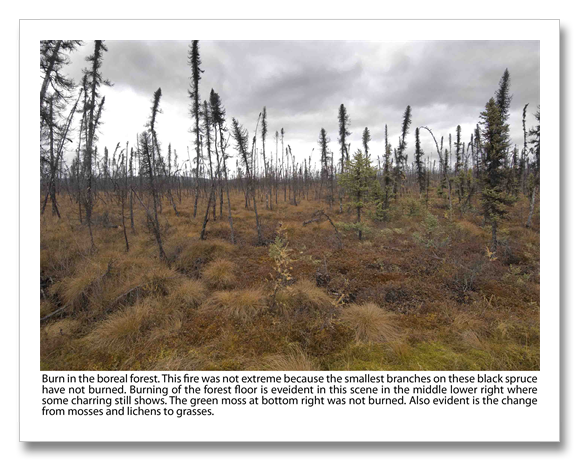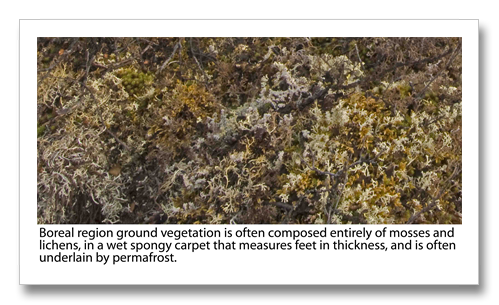This is yet another climate change impact happening before it was supposed to – a big one too. Findings from this team led by a biologist at the University of Guelph, Ontario, Canada, and including scientists from the USGS and the US Forest Service tells us that the black spruce forest of Alaska (much of the forested area in Alaska) that once sequestered 20 megatons of carbon dioxide per year, now emits 14.1 megatons of carbon per year which is equal to 52 megatons of carbon dioxide (some of the carbon emitted is methane, not carbon dioxide, but for simplicity sake, carbon dioxide is considered here.)
he projection of Alaska’s greenhouse gas balance from terrestrial sources, by Zhuang (2007) is a net emissions of 62 megatons of CO2 equivalents per year by 2100. So the findings of this research shows we are not quite a hundred years ahead of schedule, maybe 80.
The reason? Forest fires have doubled since the 1960s. Not only this, but large fires have double in frequency as well. Warming is the cause. Warming means drought, even if rainfall is normal, a warmed climate evaporates more – a lot more. More importantly though, its not just the trees that burn and release their carbon back to the atmosphere. The soils are burning too.
Northern forest soils are chock full of carbon. Because of the slow decomposition rate in the north country (ice and snow covered much of the year) organic material decomposes slowly. In addition, a great deal of the northern forest is underlain by permafrost.
Much of permafrost is made of peat. Much of peat is made up of that wonderful matt of mosses and lichens that grows
on the ground in the North. These peats only partially decompose when they die because they become entombed in ice before the decomposition process can complete.
So we have several things going on here to cause the north, the great boreal forest, to change from a carbon sink to a carbon source – and a big carbon source at that: more fires burning more trees, more trees burned up and not sequestering carbon, drier soils because of warming, more large fires, and more large fires burning deep into carbon rich peat soils that are no longer entombed in ice because the permafrost has melted.
Now the biggest thing going here is that late season fires, that burn deep into peat rich soils because late in the season those soils are at their driest, have increased four fold since the 1960s.
All told, this 52 megatons of carbon dioxide released by Alaska’s boreal forests annually is even greater than the emissions of 40 million acres of beetle killed pine in British Colombia.
Alaska’s CO2 emissions from increased forest fires due to climate warming is about equal to all of the emissions from all of Canada’s forest fires during the period 1959-1999.
These findings are extremely troubling because Alaska’s boreal forest includes less than 10 percent of the world’s boreal forest and there is no reason to believe that the rest of the world’s boreal forests are not behaving any differently than Alaska’s.
Turetsky, et.al., Recent acceleration of biomass burning and carbon losses in Alaskan forests and peatlands, Nature Geosciences, December 2010. http://www.geog.umd.edu/news/turetsky_nature_geo_2010.pdf
Kasischke and Turetsky, Recent changes in the fire regime across the NA boreal region – spatial and temporal patterns of burning across Canada and Alaska, Geophysical Research Letters, May 2006. http://www.uoguelph.ca/~mrtlab/mrtlab/Publications_files/Kas%20Tur%20GRL%202006.pdf
Zhuang et. al., Net Emissions of CH4 and CO2 in Alaska – Implications for the regions greenhouse gas budget, Ecological Applications, Volume 17, 2007. http://www.lter.uaf.edu/dev2009/pdf/1037_Zhuang_Melillo_2007.pdf
Kurz et. al.,Mountain pine beetle and forest carbon feedback to climate change Nature April 2008. http://www.macroecology.ca/spatial/kurz.pdf


